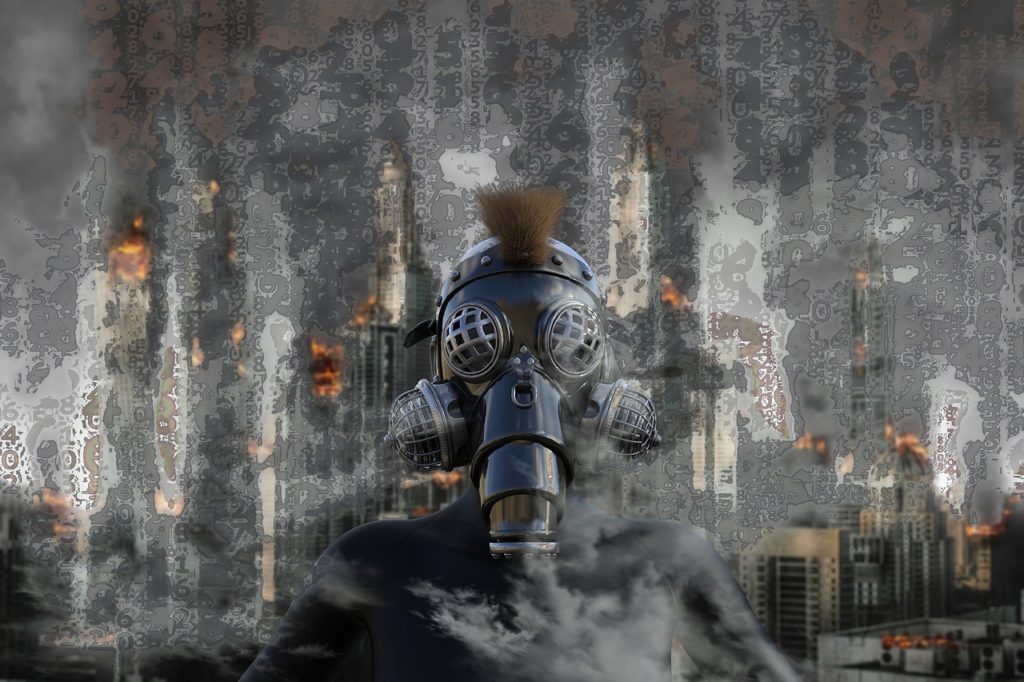Wondering how to write a post-apocalyptic novel? You’re not alone! This is one of the most popular genres under the speculative fiction “umbrella,” for readers and authors alike. And with good reason.
Apocalyptic fiction is a versatile genre that can include elements of horror, science fiction, adventure, survival, and world building — to name but a few.
But how do you go about writing it? Here are some tips, ideas and suggestions to get you started.
How to Write a Post-Apocalyptic Novel
This isn’t a writing class and there aren’t any rules. In fact, that’s why some authors choose to write post-apocalyptic novels in the first place. It gives them the creative freedom to follow their writerly instincts and chart their own course.

But if you want to know how to write a post-apocalyptic novel that engages readers, consider the seven suggestions I’ve outlined for you below.
1. Start thinking about your protagonist’s journey.
Who is your main character?
I’m not talking about their name or what they look like. I’m talking about who they are on the inside.
What does your protagonist want? What are his/her greatest fears, concerns and desires? What makes him “tick”? Knowing this will make it easier to envision your character’s quest or journey.
Most post-apocalyptic novels portray a main character (or a small group of characters) pursuing an objective. Maybe they’re trying to reach some kind of “safe zone,” while encountering obstacles along the way. Maybe they’re trying to escape from a prison-like community with harsh, authoritarian rule.
In order to write a post-apocalyptic novel, you have to know what your character wants and where those desires will take them. The more you dig into these emotions, the easier it will be to write your story.
2. Map out the storyline, or at least the beginning.
Maybe you’re a plotter, the kind of person who meticulously maps out stories ahead of time, in scene-by-scene fashion.
Maybe you’re more of a pantser, the kind of person who writes “by the seat of their pants,” figuring the story out as you go along.
Or maybe, like me, you’re a little of both.
Guess what? All of these approaches can help you reach the finish line. So feel free to choose the method that feels right for you. And then get on with the writing.
The point is this: You don’t have to have the entire story plotted or sketched out in advance. You can write a post-apocalyptic novel with or without a detailed outline. You can be a plotter, a pantser, or a “hybrid” writer who uses only a loose outline with plenty of creative wiggle-room.
But at a minimum, you need to know the beginning or opening of your story. You need to know:
- Who your protagonist is (see tip #3 above)
- Where they are at the start of the novel
- What they’re trying to do or accomplish
If you’re a total “pantser,” and you want to figure things out as you go along, you could start writing a post-apocalyptic novel with only the first two elements above. Maybe you don’t yet know what your character wants. Maybe, at the start of the novel, your character doesn’t even know what they want. Maybe they figure it out (and begin their quest) after some kind of inciting incident.
But you have to at least consider the beginning of the story, before you start writing it.
3. Show some danger at the beginning of the story.
Post-apocalyptic stories are dangerous stories. The danger is everywhere, and it ranges from unsafe drinking water to heavily-armed marauders. In this kind of setting, your character faces threats and challenges at every turn.
When writing a post-apocalyptic novel, make sure your readers know how dangerous this new world can be. Give us a glimpse of it early on, ideally within the first couple of chapters.
But just a glimpse. You don’t want to put your characters into too much trouble at this stage. Save the most intense and dangerous moments for the story’s climax.
Example: In the first chapter, your protagonist might hide in a ditch beside the road, as a group of zombies or armed gang members march past. This shows readers the kinds of threats your character will face, but in a subtle way. Later, you can intensify the threat to increase tension.
4. Be careful with your pacing.
Here’s a simplified, four-sentence summary of how to write a post-apocalyptic novel:
- Introduce your main character(s) and the world they inhabit.
- Put your protagonist on some kind of quest or journey.
- Create obstacles to challenge your protagonist.
- Increase tension gradually, until you reach the story’s climax.
Pay particular attention to that last bullet point, especially when planning your story. You might be tempted to include harrowing, life-or-death scenes within the first couple of chapters, as a way of “hooking” the reader.
But you have to ask yourself: Where can I go from there? How can I increase tension later in the story, if I come out with guns blazing in chapter one?
This is where pacing comes into the picture. The idea is to build up to an explosive climax (covered below), and to have that climax be the most intense part of the story. So be sure to consider this as you write the first chapters of your post-apocalyptic novel.
5. Challenge your characters in every way imaginable.
We touched on character challenges above. Challenges and obstacles are an important part of novel writing. Keep this in mind at all times when writing your post-apocalyptic novel.
From a storytelling standpoint, an obstacle is anything that stands in your protagonist’s way. It prevents them from achieving a certain goal or reaching a certain objective. It might be a minor setback, or a life-threatening catastrophe.
In most novels, the obstacles tend to get worse as they story goes on. (Pacing, remember?) This commonly used structure allows authors to “raise the stakes” as the story progresses. It increases the tension.
But challenges and obstacles do more than that. They also force your protagonist to act, to make decisions, to choose a path — and to reveal more of their character.
As readers, we can learn a lot about a character by seeing how they handle setbacks, challenges and hurdles. But we don’t learn much when everything goes their way. This is true for all genres of fiction.
As you set out to write your post-apocalyptic novel, think about the different challenges you can throw at your character. Think about how you might intensify them as the story progresses, until you reach the biggest challenge of all … the climax.
6. Blow us away with a big climax.
The climax of a novel is the point of highest tension and drama. It’s when the “big showdown” occurs, when the protagonist goes all out to overcome the antagonist and/or other opposing forces. It’s where the fireworks go off, from a narrative standpoint.

You get the idea.
But here’s the thing. While all types of novels need an exciting climax, it’s even more important for a post-apocalyptic novel.
People who read apocalypse-related fiction tend to have high expectations when it comes to the climax. They want to be wowed and blown away. They want the fireworks.
When writing a post-apocalyptic novel, it’s your job to meet this expectation in some way. Otherwise, your climax might end up being anticlimactic. And nobody wants that.
7. Be an agent of change.
Post-apocalyptic stories and books are all about change. One world falls, and something else rises up in its place. That’s the most obvious kind of change.
But there can be other, more subtle changes as well.
Take your protagonist, for example. How does he or she change during the course of the story? Does your character see the world in a new light? What will her life be like going forward, given the trials and tribulations she has experienced.
Or think about it this way. If nothing and nobody changes during the course of your story … what’s the point in writing it?
So there you have them, seven tips and suggestions on how to write a post-apocalyptic novel. I hope this blog post has given you some creative fuel, and I wish you well in your writing journey!
